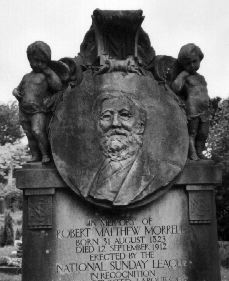Robert Morrell

Robert Morrell (1823–1912)
'Oooh I do hate Sundays . . . Every Sunday it's the same. Nowhere to go, nothing to do. Just sit here waiting for the next lot of grub to come up.'
If Tony Hancock's Sundays were dull in 1958, things were much worse 100 years earlier. This Sabbatarianism was not to everyone's taste, however, and one of those who campaigned to relax it – Robert Morrell, founder of the National Sunday League – is buried in St Pancras & Islington Cemetery.
Restrictions on Sunday activities in Britain had begun in the tenth century, and by the seventeenth century there were two schools of thought in favour of Sunday observance: one insisted that the Sabbath should be devoted solely to religious observance; another considered it a day for good works which might include labour and recreation.
In the eighteenth century, however, the Revd William Grimshaw forbade Sunday games of football and disguised himself as an old woman to detect them, driving his parishioners to church with a riding-crop.
Also, in 1780, the Sunday Observance Act was passed, imposing a 200 fine on anyone who organized any form of Sunday entertainment for which admission was charged.
In the nineteenth century the writer and artist John Ruskin (b. 1819) didn't think it proper to draw on a Sunday until he was middle-aged, and, for the fifty-two years he lived with his parents, screens were placed in front of all his pictures on a Sunday. Respectable children were forbidden to play with their toys on the Lord's Day, and might only read the Bible, Pilgrim's Progress or other improving works.
In 1851 the Great Exhibition opened in the Crystal Palace, in Hyde Park. It was claimed that 'men, whose minds religious teaching had failed to soften, were subdued at the grandeur of the sights which they there beheld, and for the first time they learnt to reverence genius, intellect and property'. Even so, when the Crystal Palace was moved to Sydenham the following year and its owners proposed opening it on Sunday afternoons, Sabbatarian pressure stopped them charging then, so it stayed shut.
In 1855 a bill restricting Sunday trading was presented to Parliament. Already irritated by the previous year's act restricting Sunday drinking hours, on three Sundays in June and July the working classes demonstrated in Hyde Park. Karl Marx, who was present, thought that the English revolution had begun.
Also present was Robert Morrell. A goldsmith and jeweller, it was his wife, he said, who had started the calls of 'Go to church!' that were directed at the well-heeled promenaders. He became convinced that the Crystal Palace and museums should be open on Sunday, and that autumn he founded the National Sunday League to campaign for this.
A year later the NSL had collected 1,622 one-shilling subscriptions, plus 151 donations from middle-class supporters.
Its pamphlets argued that on the Continent innocent Sunday amusement and recreation did not lead to more Sunday labour than existed without them in England.

Henry Mills, for forty years secretary of the National Sunday League,
is buried a few yards away from Morrell
Eventually, in 1896, Parliament did vote to open the national museums and galleries on Sunday afternoons, but the NSL carried on until the Second World War.
Morrell died in 1912. As his tombstone says, 'He strove to reform and make that day [Sunday] more beneficial for the people – certainly not to abrogate it as a day of rest.' What he would have made of the British Sunday today is anyone's guess.
Ray Galton and Alan Simpson, 'Sunday Afternoon at Home' (1958), in Hancock's Half-Hour: The Classic Years (London: BBC Books, 1987)
John Wigley, The Rise and Fall of the Victorian Sunday (Manchester: Manchester University Press, 1980)